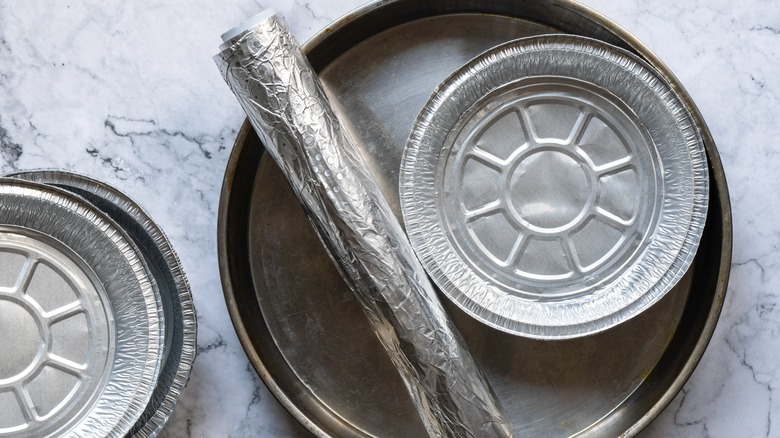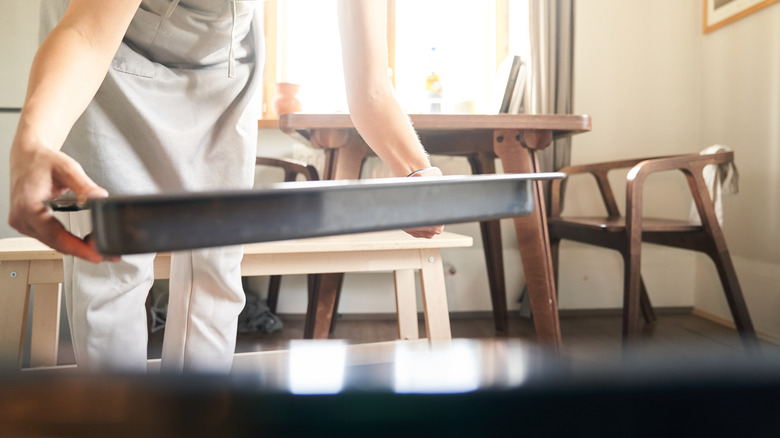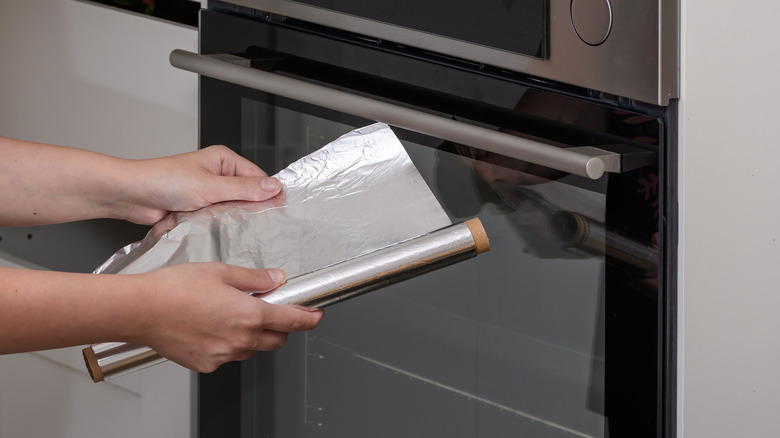Aluminum Foil Dividers Are The Quick Fix For Oversized Baking Pans
Whether you spent three hours or thirty minutes preparing a recipe that requires a baking pan, it's a serious bummer to discover you don't have the correct size of pan to bake your creation. Luckily, if you go to put your brownies in the pan and realize it's too large for the amount of batter you made, all is not lost. You can use a piece of aluminum foil to create a divider in your pan that will transform it into the exact size you need.
All you need to do is take a large piece of tin foil and fold it into a thick strip that's the same height as your baking pan. Then, put the strip of tin foil into the pan where you want the divide to be and fold the edges away from the side of the pan where you're going to place the food, so that the strip of tin foil is the same width as the pan. To help keep the divider in place, add a few perpendicular supports. Fold or roll a few pieces of tin foil into thick strips or cylinders. Then, fit these support beams into the pan so that one end pushes against the tin foil divider and the other end pushes against the side of the baking pan. This way, when the baking mixture you pour into your newly-sized pan hits the tin foil divider, the support beams will brace the divider and stop it from potentially caving in or falling over.
Importance of using the right pan size
If you've spent your afternoon whipping up the ultimate chocolate cake, it might be tempting to just cook it in whatever size baking pan you have in your kitchen — but baking pan size matters more than you may realize. Using a pan that's too big means whatever you're cooking will have more exposed surface area, which will cause the liquid in your dish to cook off more quickly. If you use a pan that's too large, your dish might not rise correctly, turn out dry, or even burn.
Using a pan that's too small can cause its own set of problems, too. Depending on what you're making, the center of your dish might turn out undercooked, or you might open the oven to find that your batter has overflowed. You can adjust baking times and temperatures to account for some of these problems, but you're usually better off ensuring you have the correct size pan before you start cooking or finding a work-around like the tin foil method for pans that are too big.
Tips for dividing baking pans
The most important thing to remember is that the aluminum foil strip you make to divide your pan needs to be sturdy enough to keep whatever you're baking in your pan from spilling into the empty space on the other side — which means it needs to be thick. Be sure to fold your tin foil multiple times until it feels like it's strong enough to stand up to your batter or casserole filling. You'll be able to tell if it's strong enough when it can stand up on its own in the pan.
When you're making the support beams for the empty side of the pan, you can make them even thicker, or roll more layers of aluminum foil over them to create stronger beams. Even though you're using a unique baking hack, don't forget that you still need to prepare the pan properly before putting food in it. You can use parchment paper, baking spray, butter, or whatever your recipe calls for. Just be sure to grease the pieces of foil too so that nothing sticks to the makeshift wall. There are plenty of aluminum foil hacks that will make your time in the kitchen a breeze, so it's always a good idea to keep a roll on hand for when unexpected issues arise.


